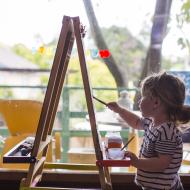Trajectory Play Pattern
Children learning through Trajectory patterns of play have a fascination with things that move. This could be household objects, toys, or even their own bodies. If your little one has an urge to kick, drop, or throw things through the air, climb or jump off things, it’s likely they are learning about movement (vertical and horizontal) through Trajectory play patterns.
So much of our children’s early-year learning is based on movement. So Trajectory play patterns can be seen even in babies — reaching, kicking, pointing, rocking, climbing or stepping up and down. Trajectory patterns evolve in toddlers and older children too — you may notice they like to play with balls, toy trucks, cars and buggies, swords and wands, or on swings and slides.
What kind of play ideas are good for those with an interest in Trajectory?
Trajectory play patterns are often noticed by parents because of some of its more challenging aspects, such as a child throwing inappropriate objects at inappropriate times (their dinner!), flicking paint around the room, or energetically knocking activities or objects off tables.
Offering an alternative Trajectory activity can help to distract and redirect your little one to more appropriate types of trajectories that still allow them to learn and explore this urge through play.
The following are constructive ways you can help support your child’s learning through their play:
- Help your little one explore how objects move by sending toy cars and balls down tubing of different lengths and sizes
- Provide them with bubbles to blow, or feathers, scarves or ribbons to drop, throw and float through the air
- Have your child help water the garden with a watering hose to explore how water moves through space
When talking to your little one, use words that link with their Trajectory fascination like run, jump, climb, swing, throw, roll, fast and slow.
Now that you know a little more about how your child learns through play, you can support their growth. If you’d like to learn more about different patterns of play (your child may be learning through more than just one), check them out below and discover loads of fun ways to support your child’s learning.
Have fun playing and learning together!



